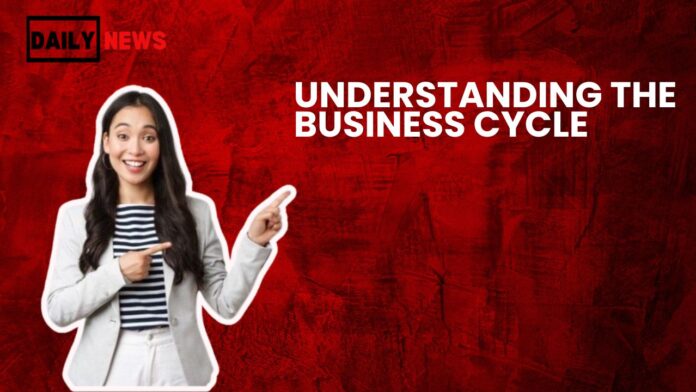The business cycle, also known as the economic cycle, represents the natural fluctuation of economic activity over time. It impacts businesses, governments, and individuals, making it a crucial concept for understanding the economy’s ups and downs. In this article, we will delve into the different stages of the business cycle, its causes, and how businesses can navigate these economic changes effectively.
What is the Business Cycle?
The business cycle refers to the periodic expansion and contraction of economic activity in a market economy. Measured by changes in GDP (Gross Domestic Product), employment rates, and other key economic indicators, the business cycle reveals the economy’s health and performance.
Economists generally classify the business cycle into four distinct phases:
- Expansion
- Peak
- Contraction (Recession)
- Trough
Phases of the Business Cycle
1. Expansion Phase
The expansion phase is characterized by economic growth, rising employment, and increasing consumer and business confidence. Key features of this phase include:
- Rising GDP: Production levels increase to meet growing consumer demand.
- Lower Unemployment: Job opportunities expand as businesses grow.
- Increased Consumer Spending: Higher incomes and optimism drive spending.
- Rising Investments: Businesses invest in infrastructure, technology, and labor to sustain growth.
- Controlled Inflation: Prices rise moderately, reflecting healthy demand.
During this phase, policymakers may focus on sustaining growth while avoiding overheating the economy, which can lead to inflationary pressures.
2. Peak Phase
The peak marks the cycle’s zenith, where economic growth reaches its maximum potential. Indicators during this phase include:
- Maximized Output: Businesses operate at full capacity.
- High Employment Rates: Unemployment rates are at their lowest.
- Potential Inflation Risks: Rapid growth can lead to overheating, increasing the likelihood of inflation.
- Stagnation in Growth: Although the economy remains strong, growth begins to slow down.
The peak is often a turning point, signaling the onset of economic contraction.
3. Contraction Phase (Recession)
The contraction phase, also referred to as a recession, is marked by a decline in economic activity. Features of this phase include:
- Decreasing GDP: A sustained drop in production and economic output.
- Rising Unemployment: Companies reduce their workforce to cut costs.
- Falling Consumer Spending: Reduced confidence leads to a decline in purchases.
- Business Failures: Weaker businesses may close due to declining revenue.
- Deflation Risks: Prices may drop due to lower demand.
Recessions vary in severity and duration, but they often prompt governments to implement fiscal and monetary policies to stimulate the economy.
4. Trough Phase
The trough is the lowest point in the business cycle. It represents the end of contraction and the start of recovery. Characteristics of the trough include:
- Stabilizing Economy: The decline in economic activity slows down.
- Increased Savings: Consumers prioritize saving over spending.
- Policy Interventions: Governments and central banks often step in with stimulus measures.
- Opportunities for Growth: The economy begins to prepare for recovery, setting the stage for the next expansion.
During the trough, businesses that adapt quickly to changing conditions are better positioned to thrive during the recovery.
Factors Influencing the Business Cycle
1. Monetary Policy
Central banks, such as the Federal Reserve, play a significant role in influencing the business cycle by adjusting interest rates and controlling the money supply.
2. Fiscal Policy
Government spending and taxation policies can stimulate or slow economic growth, directly impacting the business cycle.
3. Consumer and Business Confidence
Perceptions of economic stability affect spending and investment, influencing the cycle’s trajectory.
4. Global Events
Geopolitical tensions, pandemics, and technological advancements can disrupt or accelerate economic cycles.
How to Navigate the Business Cycle
For Businesses
- Diversify Revenue Streams: Spread risk by investing in various industries or markets.
- Monitor Economic Indicators: Stay informed about GDP growth, unemployment rates, and other metrics.
- Adopt Flexible Strategies: Be ready to adjust business operations in response to changing economic conditions.
- Focus on Efficiency: Optimize operations to reduce costs and improve profitability during downturns.
For Individuals
- Build Emergency Savings: Prepare for potential job losses or income reductions during recessions.
- Invest Wisely: Diversify your portfolio to hedge against economic fluctuations.
- Stay Informed: Keep an eye on economic trends to make informed financial decisions.
For Governments
- Implement Counter-Cyclical Policies: Use fiscal and monetary tools to stabilize the economy.
- Support Key Industries: Provide aid to sectors most affected by economic downturns.
- Encourage Employment: Invest in job creation programs to reduce unemployment.
Why Understanding the Business Cycle Matters
Understanding the business cycle helps stakeholders make informed decisions, whether it’s timing investments, managing costs, or implementing policies. Businesses can capitalize on expansion opportunities and mitigate risks during contractions, while individuals can plan their finances to weather economic uncertainties.

Er. Rishav Raj (Btech Computer Science)
Dr. Rishav Raj (Bachelor of Ayurvedic medicine and Surgery)
I am a professional blogger since 12 years worked for different healthcare blog as well as health care advisor for different multinational companies as well as Software developer for different healthcare and technology based software.i am here to share you some informative blog regarding news , healthcare and technology







